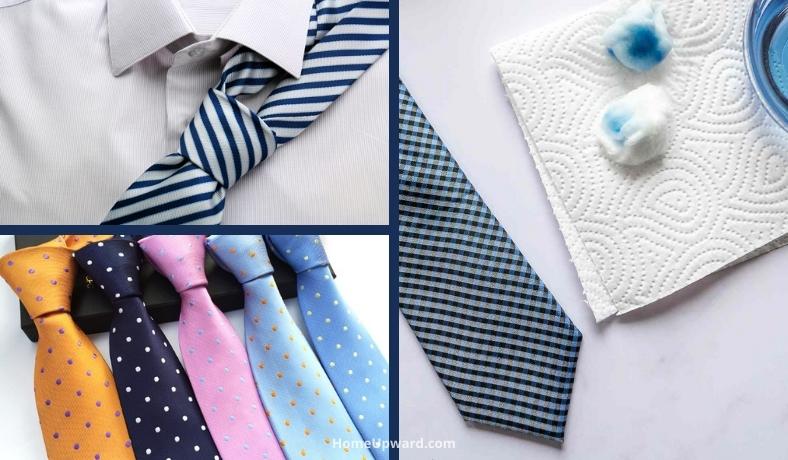It’s tricky business cleaning a tie – you can damage them or end up with frayed fabric! If you find you’ve got a stain or dirt, what is the best way to clean a tie?
You’ll learn that here and much more!
Contents
What is the best way to clean a tie?
When the time does come that a squirt of ketchup or some other substance has infiltrated the dignity of your tie, take special care to clean your tie carefully and according to recommended instructions.
Act quickly if your tie becomes stained. Blot the stain with a cloth or napkin but don’t rub it as this can make the stain set in.
Try seltzer water or club soda to remove the stain if the stain is water soluble. Use talcum powder or corn starch on the stain if it’s oil based.
If using powder, let it sit for a few hours and then try to brush it off. If the stain is not gone, try the powder again.
If stain removal methods fail or if your tie has gotten gross from being in storage or because of years of neglect, it’s time to clean the tie.
Your best bet is to either have your ties dry cleaned or wash them by hand. Different fabrics will have different recommendations and instructions.
Pay attention to the fabric and follow these tips.
Care and cleaning for different tie fabrics
Each fabric will have slightly different requirements for care. In all cases, it is recommended to never use bleach and always air dry your ties.
The dryer isn’t a friend to ties. It can damage the shell or lining.
Here is a look at the best ways to clean ties of different materials.
Silk ties
Silk is a lovely material that is cultivated mostly in India and China. It is a natural protein fiber that’s made by insects.
While it’s a highly desirable fabric, it’s quite difficult to clean. The best thing for silk is to take it to the dry cleaners.
When at the dry cleaners, ask them to hand-press the tie. This will keep the edges nice and rounded.
Never put a silk tie in the dryer if it gets wet, always hang it to dry. Never wring out a silk tie or twist it, this will cause the tie to become misshapen.
Polyester and polyester microfiber ties
For a polyester or polyester microfiber tie, it’s best to gently wash by hand in cold or warm water. When finished, use a towel to press out any excess water.
Never twist or wring the tie to remove water, as this will damage the shape of the tie. Hang the tie up to dry.
Other tie materials
There are many other materials that ties might be made of. In addition to silk, wool should also be only dry cleaned.
Other materials such as linen, cotton, seersucker, and knit should be hand washed only. Linen and cotton should be washed in cold or warm water and knit and seersucker should be washed only in cold water.
Hang all of these ties to dry except for knit, which should be reshaped and laid flat. Never wring the water out.
Real or faux leather should only be wiped clean. Never submerge or dry clean a tie of this material.
Baby wipes work well to clean real or faux leather ties. Never use any heat or steam and always hang these ties to dry if they get wet.
Can you wash ties in the washing machine?
Even though some ties may claim that they are machine washable, this isn’t a good idea. Ties are usually made of fine fabrics and a trip through the washing machine can cause shrinking, damage, and color loss.
It’s best to dry clean or hand wash ties to keep them in pristine condition.
How do you clean hand painted neckties?
Hand painted neckties are unique, make great gifts, and are a sure fire way to get noticed and stand out.
Be sure to ask about care instructions when purchasing a hand painted neck tie. If you get instructions with the purchase, hang onto them to refer to if cleaning is needed.
It is important to know what kind of paint or dye was used when making the tie so that you can take special care to ensure all colors stay on the tie. Also check out what material the tie is made of.
If there are no instructions to be found, your best bet is to have the tie dry cleaned. If you are steadfast on cleaning it yourself, hand washing in cool water is safest.
To dry the tie, set it inside of a towel and gently push to soak up any excess water. After this, lay the tie flat or hang to dry.
How to store ties
Taking the time to properly store and maintain your ties will keep them looking their best for years to come. This can also cut down on the need to clean ties since it’s so tricky.
When taking off your tie, be careful not to yank it off harshly. This can ruin the shape of the tie.
Instead, loosen the knot and try to reverse the steps you took when tying it. It’s very important to fully remove the knot when taking off a tie so that no permanent creases remain.
After removing the tie, hang it up as soon as possible. Draping a tie on a hanger or a tie rack is the best way to keep a tie looking its best.
Rolling a tie up in a drawer won’t damage the tie, but it could become wrinkled.
How to get wrinkles out of a tie
If a tie does get wrinkled, steaming is often the best choice. Ironing is also an option.
Just check the care instructions before you choose a method. Here are some general guidelines based on common tie materials.
Steam or iron can be used on cotton and seersucker. Steam only can be used on knit or wool.
It is best to steam a polyester tie, but an iron can be used on a low or medium setting. If you do iron, make sure that there are no stains on the tie, as the heat will cause a stain to set.
It is also best to steam a silk tie, but if you do need to use an iron, put a dry towel under the tie and a damp towel on top of the tie. Use the iron on the lowest setting and leave the tie in between the towels until the top towel feels dry.







